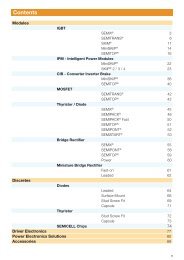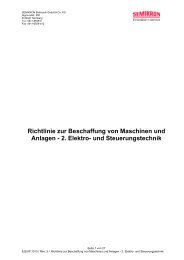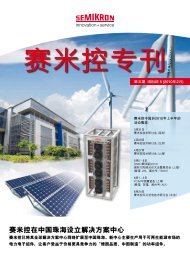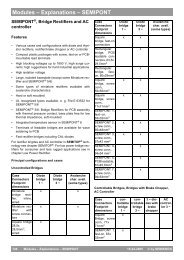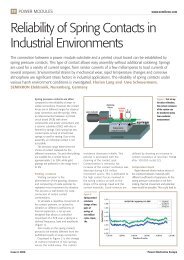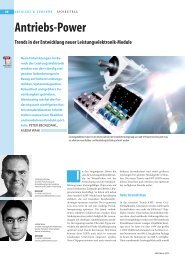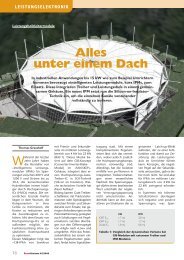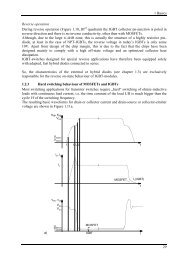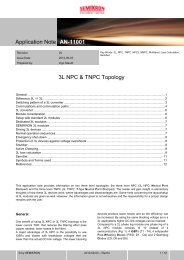Always one step ahead - Semikron
Always one step ahead - Semikron
Always one step ahead - Semikron
Create successful ePaper yourself
Turn your PDF publications into a flip-book with our unique Google optimized e-Paper software.
SKAI systems are compact power<br />
electronic systems designed for use<br />
in hybrid and electric agricultural<br />
machinery, construction machinery<br />
and hoisting and conveying<br />
equipment, as well as in any batterypowered<br />
vehicles.<br />
48<br />
E & E 08.2010
ALWAYS ONE STEP AHEAD<br />
<strong>Semikron</strong>’s innovative modules and systems are shaping the market for power<br />
electronics -- and <strong>Semikron</strong> is always up to date on the latest developments such<br />
as e-mobility or renewables.<br />
Text: Michael Brunn, Editor-in-Chief E&E<br />
E&E 08.2010<br />
Almost 60 years have passed since the first<br />
selenium rectifiers were developed at <strong>Semikron</strong><br />
Nuremberg. The face of the company today,<br />
however, is a far cry from the ‘‘back-yard’’<br />
workshop environment of 1951. In fact,<br />
<strong>Semikron</strong> is now <strong>one</strong> of the top players on the<br />
international power electronics stage. The basis<br />
for this was a groundbreaking invention in the<br />
1970s, when <strong>Semikron</strong> first managed to separate<br />
the thermal and electrical paths using ceramic<br />
layers. This basis was evolved over the course of<br />
subsequent years -- always with a view to<br />
becoming technology leader in this market. A<br />
further point that sets <strong>Semikron</strong> apart from<br />
others in this market is its innovative new ideas<br />
and packaging concepts. Here, the main aim is to<br />
tap into new markets and offer customers<br />
important advantages. What is a must here,<br />
however, is a great deal of patience. ‘‘It takes<br />
some time for new ideas and technologies to<br />
break through on a market,’’ explains Thomas<br />
Grasshoff, Head of Product Management. In this<br />
somewhat conservative market, the customers<br />
often need time to get accustomed to innovative<br />
solutions. Here, the crucial edge that <strong>Semikron</strong><br />
has is that it is an owner-run business that can<br />
pursue its own long-term strategy, irrespective of<br />
short-lived economic developments. A good<br />
example of the lengthy processes involved in the<br />
introduction of a new technology is the spring<br />
contact technology that <strong>Semikron</strong> introduced in<br />
1996 in its MiniSKiiP module. This module<br />
makes electrical contact using springs. It does not<br />
have to be soldered and can be easily integrated<br />
into automated manufacturing. In this way, far<br />
more compact converters can be made. And yet it<br />
still took a number of years for this technology to<br />
be established on the market. Today, even our<br />
competitors are using spring contact technology.<br />
Integration as a key competence<br />
When asked what the often rather broadly<br />
intended term power electronics means to<br />
<strong>Semikron</strong>, Thomas Grasshoff answers: On the<br />
<strong>one</strong> hand, it is the production of our own diodes<br />
and thyristors from wafer to chip which are then<br />
integrated into bigger systems. At <strong>Semikron</strong><br />
discrete solutions do not play a role. But it’s more<br />
than that -- it’s also the integration of electronics,<br />
driver and cooling in total systems. ‘‘<strong>Semikron</strong><br />
covers the entire supply chain on the power<br />
electronics market,’’ explains Thomas Grasshoff,<br />
from chip to module to stack. ‘‘From Chip to<br />
Systems’’ is <strong>Semikron</strong>’s motto, too. For the chief<br />
customer requirement, i.e. to make systems<br />
smaller and cheaper, cannot be met through the<br />
end product al<strong>one</strong>, but through the interplay<br />
between the individual comp<strong>one</strong>nts in the<br />
system. Here, solutions of 500W and above play a<br />
role, while low-power applications, white goods<br />
or air conditioning systems are left to<br />
competitors.<br />
International orientation<br />
Shortly after its establishment, <strong>Semikron</strong> set<br />
about moving the company to the international<br />
stage. By the 1960s, <strong>Semikron</strong> was present in<br />
Italy, France Brazil and Asia. A move that was<br />
initially driven by strong competition in<br />
Germany turned out to be the right strategy.<br />
Today, the company is present in a total of 35<br />
countries across the globe; this enables the<br />
company to offer customers individual solutions<br />
that meet their specific demands and gain early<br />
insight into the market and market trends. But<br />
these offices are more than just sales offices. In<br />
fact, on-site development engineers and<br />
application experts are available to implement<br />
custom solutions. Production sites also exist at<br />
various locations. ‘‘One product intended for the<br />
global market is manufactured at <strong>one</strong> location,’’<br />
49<br />
E & E 08.2010
SKiiP 4 features sintered rather than soldered IGBT`s<br />
and diodes and boasts 4 times the load cycling<br />
capacity, making it far more robust than modules with<br />
soldered connections.<br />
says Thomas Grasshoff, describing the principle.<br />
Every production location is a competence centre<br />
in itself. For example, chip, diode and thyristor<br />
production is in Germany, as is pressure contact<br />
technology, while in Slovakia traditional<br />
baseplate modules are made. Incidentally, at<br />
<strong>Semikron</strong> relocation to other locations is d<strong>one</strong> for<br />
a very simple reason, namely to create space in<br />
Nuremberg for new technologies.<br />
New growth markets<br />
As is the case with many manufacturers of power<br />
electronics, the drives sector plays a major role<br />
for <strong>Semikron</strong> too. This market accounts for more<br />
than 50 percent of the entire power electronics<br />
market worldwide. The cost pressure on this<br />
market is particularly strong, which is why highly<br />
cost-efficient assembly and connection<br />
technologies are needed. In the past ten years,<br />
however, two other sectors have brought about<br />
huge growth on the power electronics market. In<br />
fact, as a result of the ever urgent call for energy<br />
efficiency and energy savings, the areas of<br />
renewables and e-mobility have taken on great<br />
significance. This can be seen at <strong>Semikron</strong>, too.<br />
For example, not only has the number of<br />
employees seen a huge increase over the same<br />
period from 2,000 to 3,200. In fact, this year the<br />
area of renewables is on a par with conventional<br />
powertrains sector as regards turnover figures.<br />
Ruggedness is a must<br />
In the area of renewable energy, <strong>Semikron</strong> is<br />
active on the wind and solar power front. As<br />
much as 20 years ago, <strong>Semikron</strong> was involved in<br />
the production of the first IGBT-controlled wind<br />
power units. This quick move onto this market<br />
has now paid off: around 50 percent of the total<br />
wind power installed globally today features<br />
<strong>Semikron</strong> inverter technology. And the prospects<br />
continue to be good: experts are expecting to see<br />
20-25% growth on the wind power market each<br />
year. Here, the focus is on the expansion of<br />
capacity, on the <strong>one</strong> hand, and technical<br />
improvement, on the other. Reliability is <strong>one</strong> of<br />
the most important criteria for wind power<br />
applications. A further important aspect here is<br />
space, since the inverters are normally installed in<br />
the turbine nacelle.<br />
In the next generation of SKiiP modules,<br />
<strong>Semikron</strong> came up<br />
with an advanced<br />
solution. The<br />
module comprising<br />
driver and power<br />
circuitries and heat<br />
sink offers up to 30<br />
percent more power<br />
density than its<br />
predecessor, thus<br />
Thomas Grasshoff,<br />
Head of Product<br />
Management<br />
SEMIKRON<br />
saving space and<br />
costs. In addition, the<br />
switching losses are<br />
20 percent lower,<br />
meaning more<br />
energy can be<br />
converted. ‘‘As the IGBT’s and diodes are no<br />
longer soldered but sintered instead, SKiiP 4 has<br />
four times the load cycling capacity,’’ explains<br />
product manager Andreas Winterholler. ‘‘This is<br />
why SKiiP 4 modules are far more robust than<br />
soldered modules, which is why the failure rate is<br />
lower’’.<br />
In offshore wind parks, failure is particularly<br />
disastrous, which is why <strong>Semikron</strong> offers an<br />
additional burn-in-test in which the inverters are<br />
tested to their specification limits for 60 and 120<br />
minutes. SKiiP 4 modules include a further<br />
novelty - a digital driver. As a result, fewer<br />
comp<strong>one</strong>nts are needed and the interface is less<br />
sensitive to interference. The use of a diagnosis<br />
50<br />
E & E 08.2010
MiniSKIIP module - first integrated IGBT power<br />
inverter module in solder-free spring contact<br />
technology<br />
51<br />
interface enables differentiated error analysis.<br />
These modules also feature an intelliOff function<br />
for optimum turn-off based on three adjustable<br />
resistances.<br />
Systems for wind and solar power<br />
The significance of a systems and integration<br />
approach is particularly important for wind<br />
power applications. The manufacturers of WPUs<br />
do not come from the electronics sector and<br />
therefore need finished systems that meet their<br />
demands. This is where <strong>Semikron</strong> comes in,<br />
offering suitable stacks featuring power<br />
electronics, driver and heat sink in <strong>one</strong> system.<br />
The same applies to solar power systems<br />
manufacturers whose key competence is not<br />
electronics either. Here, <strong>Semikron</strong> makes a<br />
distinction between low-power solutions up to 5<br />
kW for use in private applications and centralised<br />
inverters for large solar parks with outputs of up<br />
to 500 kW - a figure which is on the rise. At the<br />
moment, 3-level and multi-level inverters are in<br />
particularly high demand for solar applications.<br />
These inverters, originally used in UPS systems,<br />
provide a better approximation of the desired<br />
sinusoidal wave. A further merit of multi-level<br />
inverters is that they offer three voltage states,<br />
while in other modules ON and OFF are the only<br />
possible voltage states. In solar applications,<br />
where efficiency is crucial, the energy has to be<br />
fed into the grid with minimum losses. 3-level<br />
inverters enable higher voltages and<br />
correspondingly lower currents. In comparison<br />
to 2-switch topologies, this brings about a 1.5 -<br />
2% increase in efficiency.<br />
In general,<br />
renewable energies<br />
pose entirely new<br />
problems for<br />
electricity<br />
companies and<br />
consequently for<br />
power electronic<br />
systems, too. Besides<br />
the previous topdown<br />
infrastructure<br />
from the power plant<br />
Andreas Winterholler, to the consumer, we<br />
Product Manager<br />
now have a situation<br />
SEMIKRON<br />
International<br />
where power is being<br />
fed into different<br />
grids from various power generation systems. In<br />
addition to dynamic consumption, we are now<br />
suddenly faced with dynamic grid feed, too.<br />
These fluctuations have to be offset by grid<br />
operators -- a huge challenge for power electronic<br />
systems.<br />
E-mobility<br />
A further new challenge is e-mobility. But here,<br />
too, <strong>Semikron</strong> boasts a wealth of experience: in<br />
the 1990s power electronics were used for the<br />
first ever hybrid vehicles; for almost 20 years<br />
<strong>Semikron</strong> has been <strong>one</strong> of the main suppliers of<br />
technology for forklift equipment. The takeover<br />
of Compact Dynamics opens up possibilities for<br />
the electronics industry at large on <strong>one</strong> of the<br />
most viable future markets. This takeover has<br />
brought about innovative technologies used in<br />
race cars which are to be implemented in<br />
conventional vehicles in the future. In the<br />
E & E 08.2010
mobility industry, too, <strong>Semikron</strong>’s core<br />
competence lies in the integration of power and<br />
drive electronics. ‘‘We believe that these two areas<br />
will become even more closely entwined in the<br />
future,’’ explains Thomas Grasshoff. ‘‘It has to be<br />
small and lightweight and mustn’t cost much<br />
either.’’ According to Mr Grasshoff, costs are<br />
instrumental to the breakthrough of hybrid and<br />
electric vehicles.<br />
Technology pi<strong>one</strong>er<br />
‘‘The reduction of losses, size and cooling<br />
measures -- these are the three areas where power<br />
electronics come into play,’’ says Thomas<br />
Grasshoff, explaining the role of power electronic<br />
systems. Here, a number of factors are important,<br />
not least new assembly and connection<br />
technologies. For example, for some time now<br />
<strong>Semikron</strong> has been using sintered rather than<br />
conventional soldered connections -- an<br />
impressive example of how existing technologies<br />
can be used to create innovative new solutions --<br />
and has really shaken up the market. According<br />
to experts, the next logical <strong>step</strong> here is to<br />
eliminate bond connections entirely to enable<br />
higher temperatures. ‘‘Step by <strong>step</strong> <strong>one</strong> weak<br />
point after another is being eliminated and new,<br />
improved solutions are taking their place,’’ says<br />
Andreas Winterholler, explaining the <strong>Semikron</strong><br />
approach. <strong>Semikron</strong> is continuing to work on<br />
setting the pace in power electronics. Even<br />
competitors duly recognise the innovative<br />
strength of the Nuremberg-based company. The<br />
real thanks, however, goes to the customers, who<br />
put their trust in <strong>Semikron</strong> power electronic<br />
systems time and again.<br />
Copyright: E&E<br />
52<br />
E & E 08.2010



